Business Finance Report: Performance Analysis of T-shirt Limited
VerifiedAdded on 2023/01/05
|14
|3506
|22
Report
AI Summary
This report provides a comprehensive analysis of the financial performance of T-shirt Limited. It begins with an examination of the company's statement of profit and loss, including key financial ratios such as gross profit ratio, net profit ratio, and operating profit ratio, comparing the years 2018 and 2019. The analysis highlights the company's declining profitability and operational efficiency. The report then delves into the statement of financial position, evaluating the current ratio, receivable turnover ratio, and payable turnover ratio to assess the company's liquidity and efficiency in managing its assets and liabilities. Part 2 of the report explains the concepts of accrual accounting versus cash accounting, outlining their advantages and disadvantages with an illustrative example. It also differentiates between profit and cash flow, emphasizing their distinct roles in assessing a company's financial health. Finally, the report defines a budget and explains its purposes in financial planning and control.

Business Finance
Paraphrase This Document
Need a fresh take? Get an instant paraphrase of this document with our AI Paraphraser
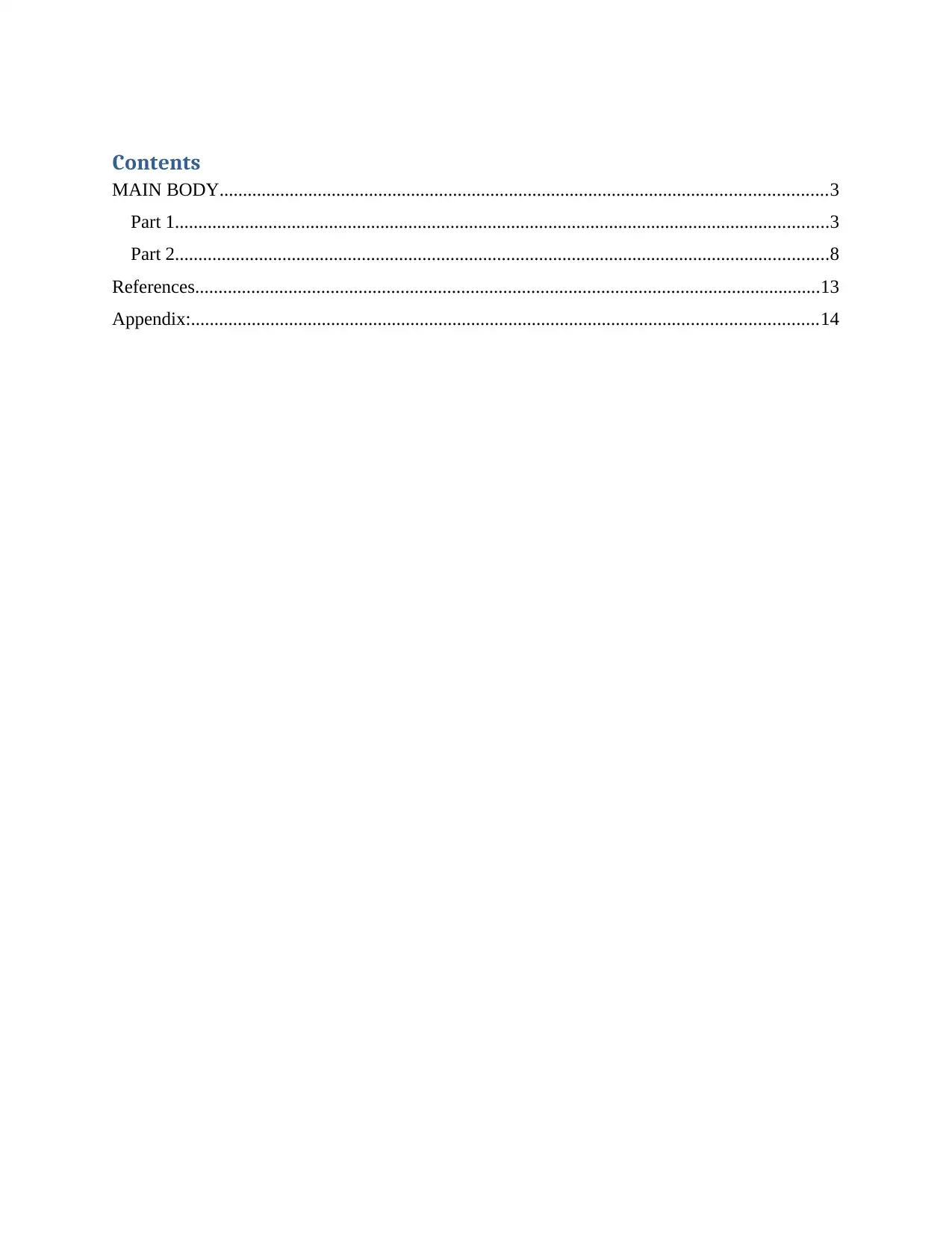
Contents
MAIN BODY..................................................................................................................................3
Part 1............................................................................................................................................3
Part 2............................................................................................................................................8
References......................................................................................................................................13
Appendix:......................................................................................................................................14
MAIN BODY..................................................................................................................................3
Part 1............................................................................................................................................3
Part 2............................................................................................................................................8
References......................................................................................................................................13
Appendix:......................................................................................................................................14
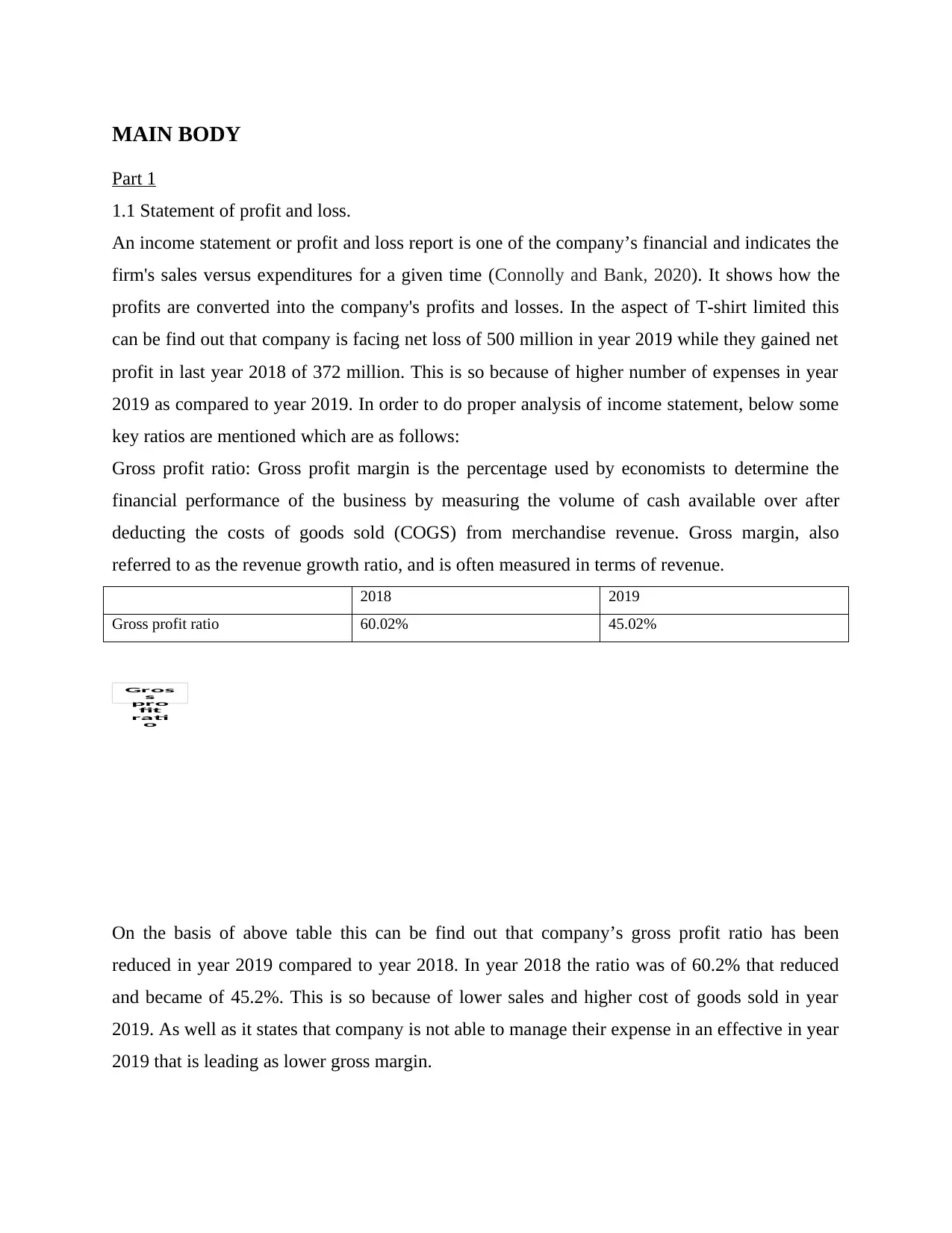
MAIN BODY
Part 1
1.1 Statement of profit and loss.
An income statement or profit and loss report is one of the company’s financial and indicates the
firm's sales versus expenditures for a given time (Connolly and Bank, 2020). It shows how the
profits are converted into the company's profits and losses. In the aspect of T-shirt limited this
can be find out that company is facing net loss of 500 million in year 2019 while they gained net
profit in last year 2018 of 372 million. This is so because of higher number of expenses in year
2019 as compared to year 2019. In order to do proper analysis of income statement, below some
key ratios are mentioned which are as follows:
Gross profit ratio: Gross profit margin is the percentage used by economists to determine the
financial performance of the business by measuring the volume of cash available over after
deducting the costs of goods sold (COGS) from merchandise revenue. Gross margin, also
referred to as the revenue growth ratio, and is often measured in terms of revenue.
2018 2019
Gross profit ratio 60.02% 45.02%
Gros
s
pro
fit
rati
o
On the basis of above table this can be find out that company’s gross profit ratio has been
reduced in year 2019 compared to year 2018. In year 2018 the ratio was of 60.2% that reduced
and became of 45.2%. This is so because of lower sales and higher cost of goods sold in year
2019. As well as it states that company is not able to manage their expense in an effective in year
2019 that is leading as lower gross margin.
Part 1
1.1 Statement of profit and loss.
An income statement or profit and loss report is one of the company’s financial and indicates the
firm's sales versus expenditures for a given time (Connolly and Bank, 2020). It shows how the
profits are converted into the company's profits and losses. In the aspect of T-shirt limited this
can be find out that company is facing net loss of 500 million in year 2019 while they gained net
profit in last year 2018 of 372 million. This is so because of higher number of expenses in year
2019 as compared to year 2019. In order to do proper analysis of income statement, below some
key ratios are mentioned which are as follows:
Gross profit ratio: Gross profit margin is the percentage used by economists to determine the
financial performance of the business by measuring the volume of cash available over after
deducting the costs of goods sold (COGS) from merchandise revenue. Gross margin, also
referred to as the revenue growth ratio, and is often measured in terms of revenue.
2018 2019
Gross profit ratio 60.02% 45.02%
Gros
s
pro
fit
rati
o
On the basis of above table this can be find out that company’s gross profit ratio has been
reduced in year 2019 compared to year 2018. In year 2018 the ratio was of 60.2% that reduced
and became of 45.2%. This is so because of lower sales and higher cost of goods sold in year
2019. As well as it states that company is not able to manage their expense in an effective in year
2019 that is leading as lower gross margin.
⊘ This is a preview!⊘
Do you want full access?
Subscribe today to unlock all pages.

Trusted by 1+ million students worldwide
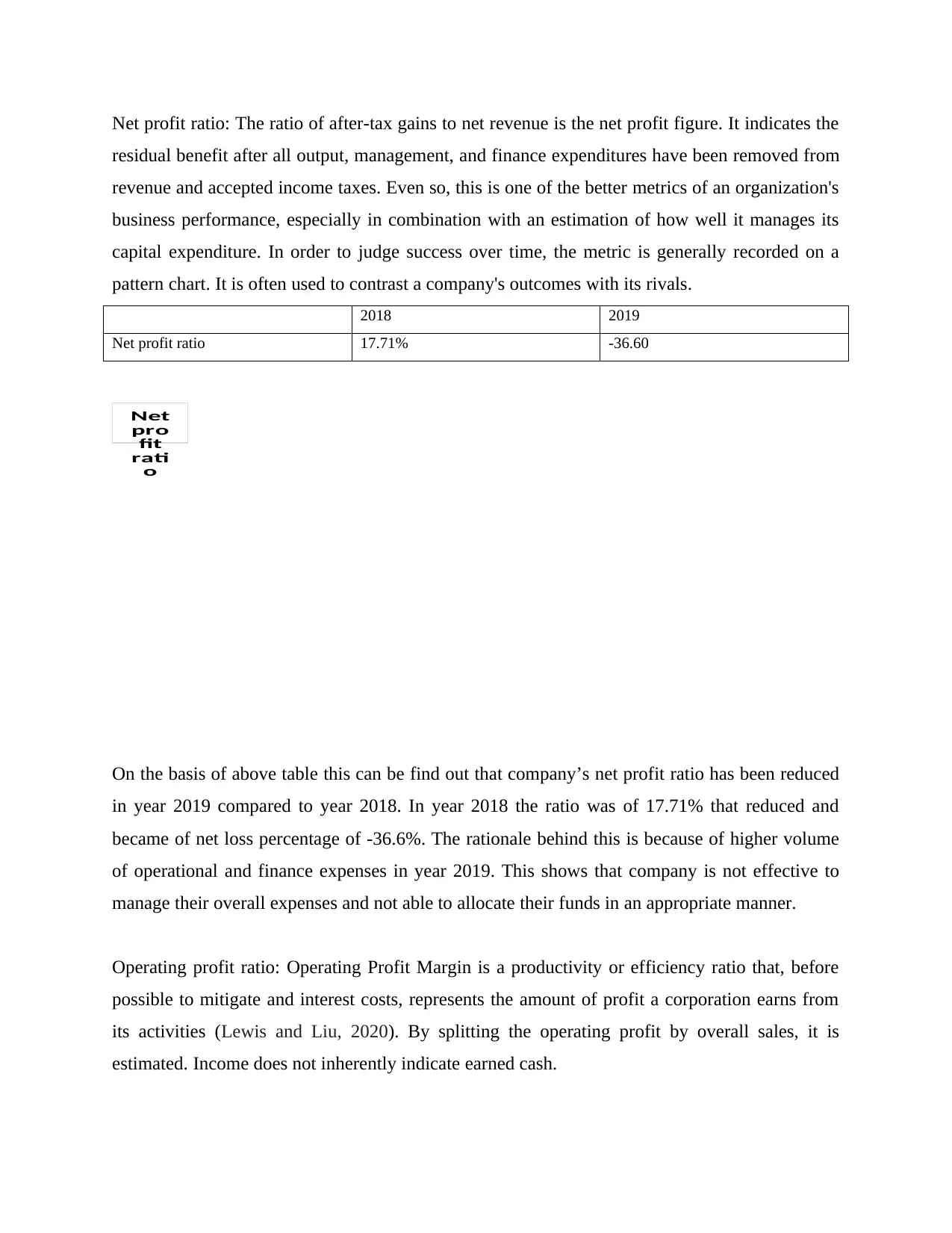
Net profit ratio: The ratio of after-tax gains to net revenue is the net profit figure. It indicates the
residual benefit after all output, management, and finance expenditures have been removed from
revenue and accepted income taxes. Even so, this is one of the better metrics of an organization's
business performance, especially in combination with an estimation of how well it manages its
capital expenditure. In order to judge success over time, the metric is generally recorded on a
pattern chart. It is often used to contrast a company's outcomes with its rivals.
2018 2019
Net profit ratio 17.71% -36.60
Net
pro
fit
rati
o
On the basis of above table this can be find out that company’s net profit ratio has been reduced
in year 2019 compared to year 2018. In year 2018 the ratio was of 17.71% that reduced and
became of net loss percentage of -36.6%. The rationale behind this is because of higher volume
of operational and finance expenses in year 2019. This shows that company is not effective to
manage their overall expenses and not able to allocate their funds in an appropriate manner.
Operating profit ratio: Operating Profit Margin is a productivity or efficiency ratio that, before
possible to mitigate and interest costs, represents the amount of profit a corporation earns from
its activities (Lewis and Liu, 2020). By splitting the operating profit by overall sales, it is
estimated. Income does not inherently indicate earned cash.
residual benefit after all output, management, and finance expenditures have been removed from
revenue and accepted income taxes. Even so, this is one of the better metrics of an organization's
business performance, especially in combination with an estimation of how well it manages its
capital expenditure. In order to judge success over time, the metric is generally recorded on a
pattern chart. It is often used to contrast a company's outcomes with its rivals.
2018 2019
Net profit ratio 17.71% -36.60
Net
pro
fit
rati
o
On the basis of above table this can be find out that company’s net profit ratio has been reduced
in year 2019 compared to year 2018. In year 2018 the ratio was of 17.71% that reduced and
became of net loss percentage of -36.6%. The rationale behind this is because of higher volume
of operational and finance expenses in year 2019. This shows that company is not effective to
manage their overall expenses and not able to allocate their funds in an appropriate manner.
Operating profit ratio: Operating Profit Margin is a productivity or efficiency ratio that, before
possible to mitigate and interest costs, represents the amount of profit a corporation earns from
its activities (Lewis and Liu, 2020). By splitting the operating profit by overall sales, it is
estimated. Income does not inherently indicate earned cash.
Paraphrase This Document
Need a fresh take? Get an instant paraphrase of this document with our AI Paraphraser
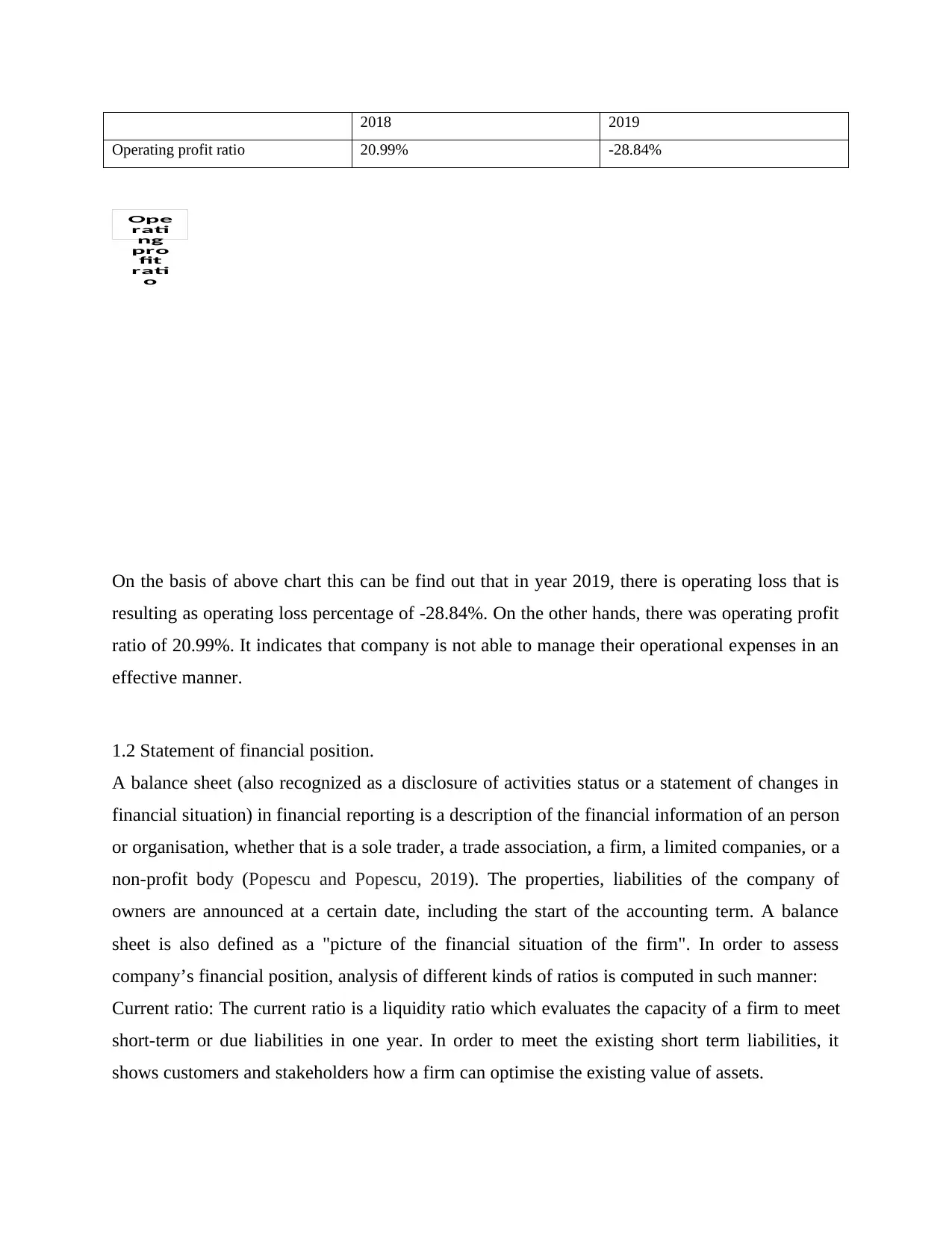
2018 2019
Operating profit ratio 20.99% -28.84%
Ope
rati
ng
pro
fit
rati
o
On the basis of above chart this can be find out that in year 2019, there is operating loss that is
resulting as operating loss percentage of -28.84%. On the other hands, there was operating profit
ratio of 20.99%. It indicates that company is not able to manage their operational expenses in an
effective manner.
1.2 Statement of financial position.
A balance sheet (also recognized as a disclosure of activities status or a statement of changes in
financial situation) in financial reporting is a description of the financial information of an person
or organisation, whether that is a sole trader, a trade association, a firm, a limited companies, or a
non-profit body (Popescu and Popescu, 2019). The properties, liabilities of the company of
owners are announced at a certain date, including the start of the accounting term. A balance
sheet is also defined as a "picture of the financial situation of the firm". In order to assess
company’s financial position, analysis of different kinds of ratios is computed in such manner:
Current ratio: The current ratio is a liquidity ratio which evaluates the capacity of a firm to meet
short-term or due liabilities in one year. In order to meet the existing short term liabilities, it
shows customers and stakeholders how a firm can optimise the existing value of assets.
Operating profit ratio 20.99% -28.84%
Ope
rati
ng
pro
fit
rati
o
On the basis of above chart this can be find out that in year 2019, there is operating loss that is
resulting as operating loss percentage of -28.84%. On the other hands, there was operating profit
ratio of 20.99%. It indicates that company is not able to manage their operational expenses in an
effective manner.
1.2 Statement of financial position.
A balance sheet (also recognized as a disclosure of activities status or a statement of changes in
financial situation) in financial reporting is a description of the financial information of an person
or organisation, whether that is a sole trader, a trade association, a firm, a limited companies, or a
non-profit body (Popescu and Popescu, 2019). The properties, liabilities of the company of
owners are announced at a certain date, including the start of the accounting term. A balance
sheet is also defined as a "picture of the financial situation of the firm". In order to assess
company’s financial position, analysis of different kinds of ratios is computed in such manner:
Current ratio: The current ratio is a liquidity ratio which evaluates the capacity of a firm to meet
short-term or due liabilities in one year. In order to meet the existing short term liabilities, it
shows customers and stakeholders how a firm can optimise the existing value of assets.

2018 2019
Current ratio 2.59 times 0.91 times
Curr
ent
rati
o
The above chart shows that company is not able to maintain ideal current ratio which is of 2:1
times in year 2019. In year 2018, company’s ratio was of 2.59 times while in year 2019 it was of
0.91 times. It indicates that company is not able to pay current liabilities from their current
assets. Hence, it is important to manage their short term expenses so that current ratio can
become ideal.
Receivable turnover ratio: It is a statistical measurement used to determine how successful a
corporation is in expanding credit as well as accumulating debts (Hasan, Popp and Oláh, 2020).
The turnover ratio of receivables is an operation ratio that calculates how well a business uses its
assets.
2018 2019
Receivable turnover ratio 9.64 times 4.48 times
Current ratio 2.59 times 0.91 times
Curr
ent
rati
o
The above chart shows that company is not able to maintain ideal current ratio which is of 2:1
times in year 2019. In year 2018, company’s ratio was of 2.59 times while in year 2019 it was of
0.91 times. It indicates that company is not able to pay current liabilities from their current
assets. Hence, it is important to manage their short term expenses so that current ratio can
become ideal.
Receivable turnover ratio: It is a statistical measurement used to determine how successful a
corporation is in expanding credit as well as accumulating debts (Hasan, Popp and Oláh, 2020).
The turnover ratio of receivables is an operation ratio that calculates how well a business uses its
assets.
2018 2019
Receivable turnover ratio 9.64 times 4.48 times
⊘ This is a preview!⊘
Do you want full access?
Subscribe today to unlock all pages.

Trusted by 1+ million students worldwide
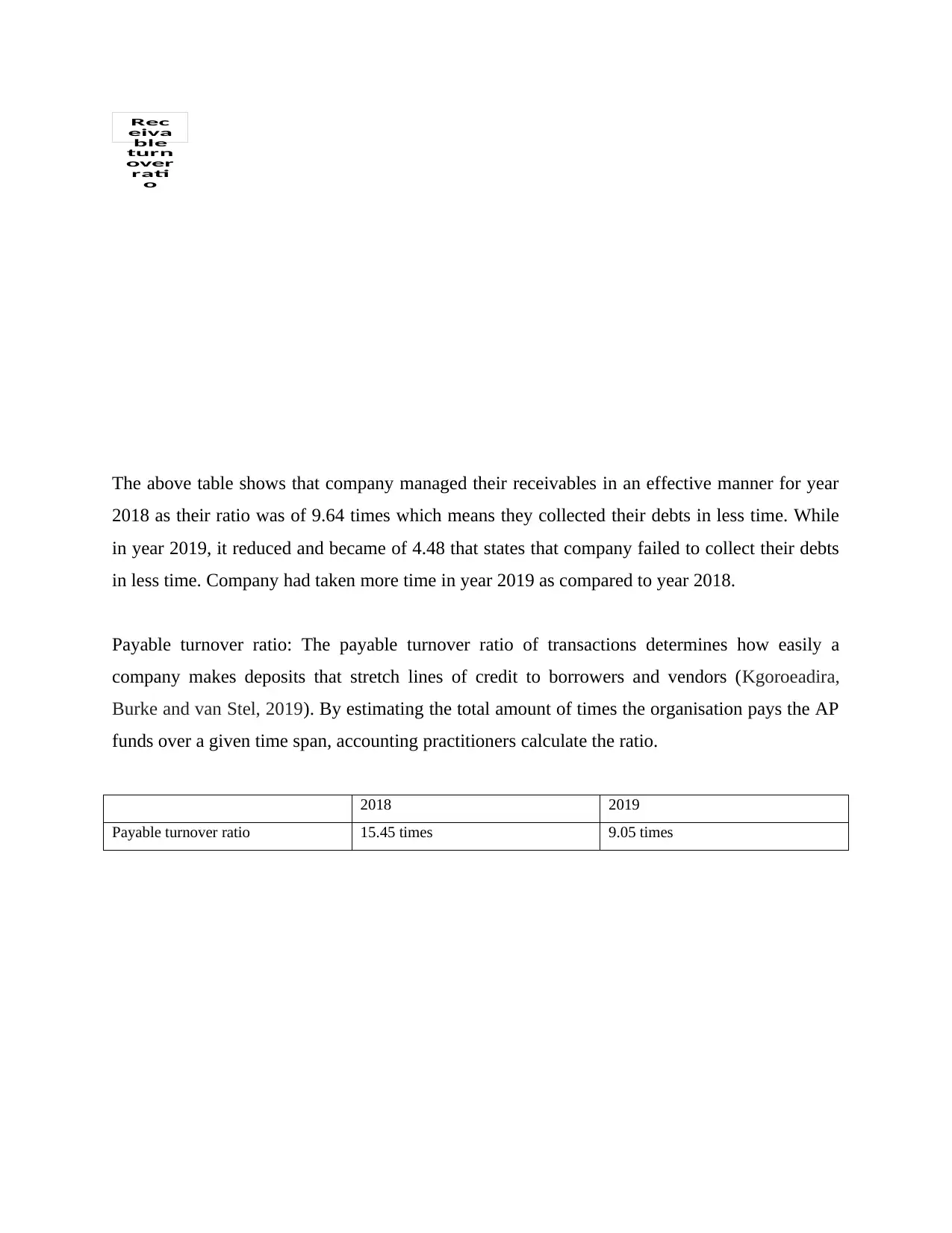
Rec
eiva
ble
turn
over
rati
o
The above table shows that company managed their receivables in an effective manner for year
2018 as their ratio was of 9.64 times which means they collected their debts in less time. While
in year 2019, it reduced and became of 4.48 that states that company failed to collect their debts
in less time. Company had taken more time in year 2019 as compared to year 2018.
Payable turnover ratio: The payable turnover ratio of transactions determines how easily a
company makes deposits that stretch lines of credit to borrowers and vendors (Kgoroeadira,
Burke and van Stel, 2019). By estimating the total amount of times the organisation pays the AP
funds over a given time span, accounting practitioners calculate the ratio.
2018 2019
Payable turnover ratio 15.45 times 9.05 times
eiva
ble
turn
over
rati
o
The above table shows that company managed their receivables in an effective manner for year
2018 as their ratio was of 9.64 times which means they collected their debts in less time. While
in year 2019, it reduced and became of 4.48 that states that company failed to collect their debts
in less time. Company had taken more time in year 2019 as compared to year 2018.
Payable turnover ratio: The payable turnover ratio of transactions determines how easily a
company makes deposits that stretch lines of credit to borrowers and vendors (Kgoroeadira,
Burke and van Stel, 2019). By estimating the total amount of times the organisation pays the AP
funds over a given time span, accounting practitioners calculate the ratio.
2018 2019
Payable turnover ratio 15.45 times 9.05 times
Paraphrase This Document
Need a fresh take? Get an instant paraphrase of this document with our AI Paraphraser
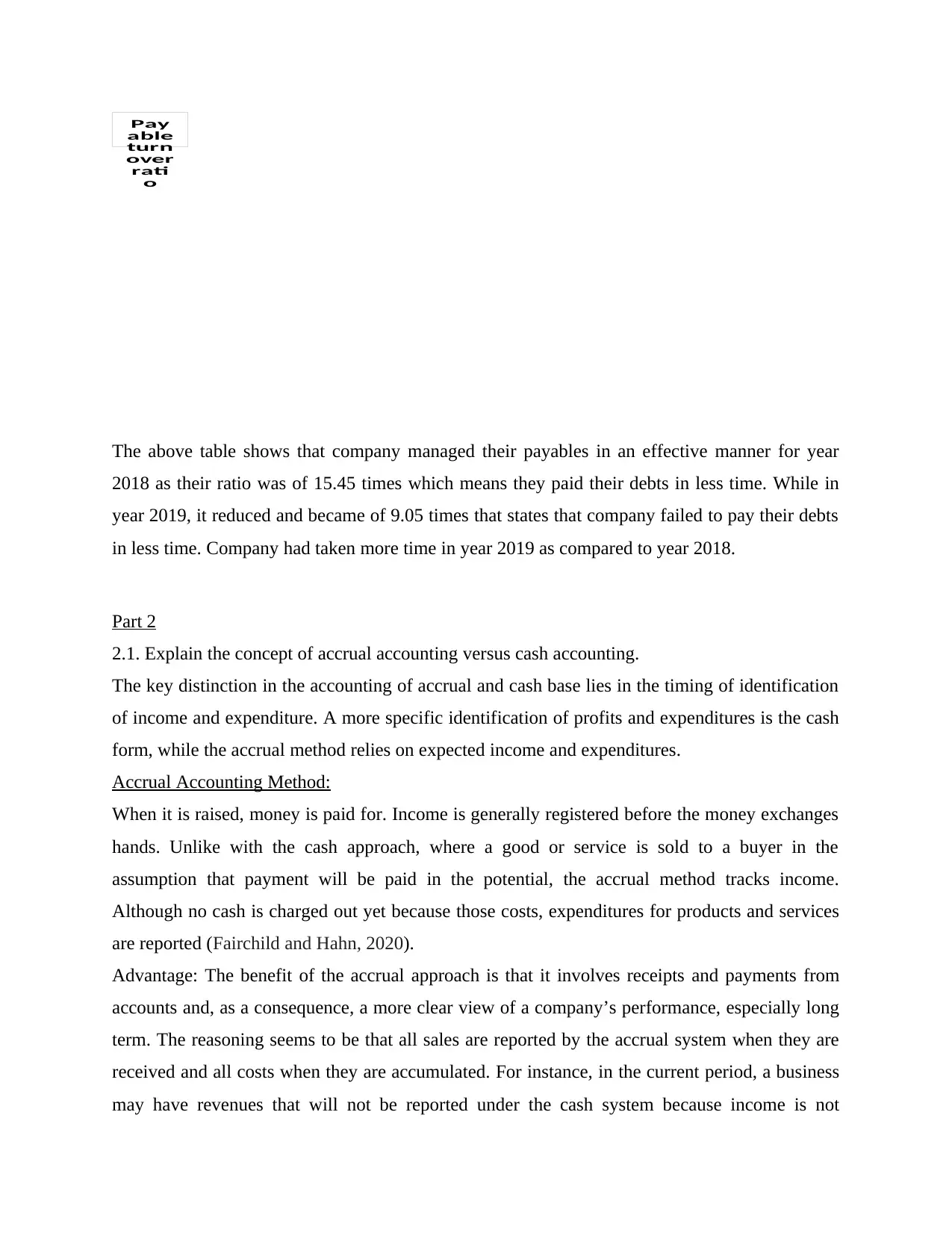
Pay
able
turn
over
rati
o
The above table shows that company managed their payables in an effective manner for year
2018 as their ratio was of 15.45 times which means they paid their debts in less time. While in
year 2019, it reduced and became of 9.05 times that states that company failed to pay their debts
in less time. Company had taken more time in year 2019 as compared to year 2018.
Part 2
2.1. Explain the concept of accrual accounting versus cash accounting.
The key distinction in the accounting of accrual and cash base lies in the timing of identification
of income and expenditure. A more specific identification of profits and expenditures is the cash
form, while the accrual method relies on expected income and expenditures.
Accrual Accounting Method:
When it is raised, money is paid for. Income is generally registered before the money exchanges
hands. Unlike with the cash approach, where a good or service is sold to a buyer in the
assumption that payment will be paid in the potential, the accrual method tracks income.
Although no cash is charged out yet because those costs, expenditures for products and services
are reported (Fairchild and Hahn, 2020).
Advantage: The benefit of the accrual approach is that it involves receipts and payments from
accounts and, as a consequence, a more clear view of a company’s performance, especially long
term. The reasoning seems to be that all sales are reported by the accrual system when they are
received and all costs when they are accumulated. For instance, in the current period, a business
may have revenues that will not be reported under the cash system because income is not
able
turn
over
rati
o
The above table shows that company managed their payables in an effective manner for year
2018 as their ratio was of 15.45 times which means they paid their debts in less time. While in
year 2019, it reduced and became of 9.05 times that states that company failed to pay their debts
in less time. Company had taken more time in year 2019 as compared to year 2018.
Part 2
2.1. Explain the concept of accrual accounting versus cash accounting.
The key distinction in the accounting of accrual and cash base lies in the timing of identification
of income and expenditure. A more specific identification of profits and expenditures is the cash
form, while the accrual method relies on expected income and expenditures.
Accrual Accounting Method:
When it is raised, money is paid for. Income is generally registered before the money exchanges
hands. Unlike with the cash approach, where a good or service is sold to a buyer in the
assumption that payment will be paid in the potential, the accrual method tracks income.
Although no cash is charged out yet because those costs, expenditures for products and services
are reported (Fairchild and Hahn, 2020).
Advantage: The benefit of the accrual approach is that it involves receipts and payments from
accounts and, as a consequence, a more clear view of a company’s performance, especially long
term. The reasoning seems to be that all sales are reported by the accrual system when they are
received and all costs when they are accumulated. For instance, in the current period, a business
may have revenues that will not be reported under the cash system because income is not
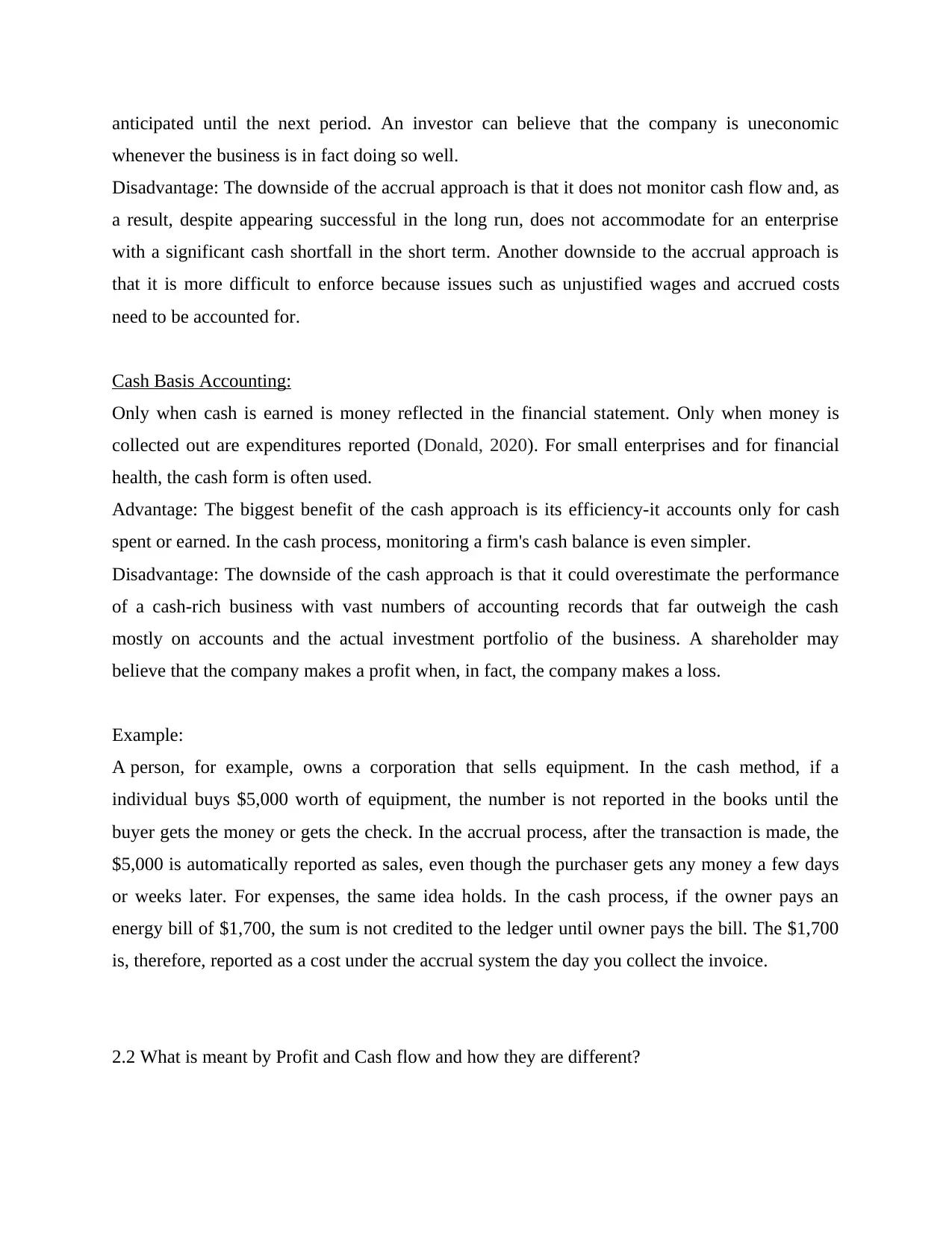
anticipated until the next period. An investor can believe that the company is uneconomic
whenever the business is in fact doing so well.
Disadvantage: The downside of the accrual approach is that it does not monitor cash flow and, as
a result, despite appearing successful in the long run, does not accommodate for an enterprise
with a significant cash shortfall in the short term. Another downside to the accrual approach is
that it is more difficult to enforce because issues such as unjustified wages and accrued costs
need to be accounted for.
Cash Basis Accounting:
Only when cash is earned is money reflected in the financial statement. Only when money is
collected out are expenditures reported (Donald, 2020). For small enterprises and for financial
health, the cash form is often used.
Advantage: The biggest benefit of the cash approach is its efficiency-it accounts only for cash
spent or earned. In the cash process, monitoring a firm's cash balance is even simpler.
Disadvantage: The downside of the cash approach is that it could overestimate the performance
of a cash-rich business with vast numbers of accounting records that far outweigh the cash
mostly on accounts and the actual investment portfolio of the business. A shareholder may
believe that the company makes a profit when, in fact, the company makes a loss.
Example:
A person, for example, owns a corporation that sells equipment. In the cash method, if a
individual buys $5,000 worth of equipment, the number is not reported in the books until the
buyer gets the money or gets the check. In the accrual process, after the transaction is made, the
$5,000 is automatically reported as sales, even though the purchaser gets any money a few days
or weeks later. For expenses, the same idea holds. In the cash process, if the owner pays an
energy bill of $1,700, the sum is not credited to the ledger until owner pays the bill. The $1,700
is, therefore, reported as a cost under the accrual system the day you collect the invoice.
2.2 What is meant by Profit and Cash flow and how they are different?
whenever the business is in fact doing so well.
Disadvantage: The downside of the accrual approach is that it does not monitor cash flow and, as
a result, despite appearing successful in the long run, does not accommodate for an enterprise
with a significant cash shortfall in the short term. Another downside to the accrual approach is
that it is more difficult to enforce because issues such as unjustified wages and accrued costs
need to be accounted for.
Cash Basis Accounting:
Only when cash is earned is money reflected in the financial statement. Only when money is
collected out are expenditures reported (Donald, 2020). For small enterprises and for financial
health, the cash form is often used.
Advantage: The biggest benefit of the cash approach is its efficiency-it accounts only for cash
spent or earned. In the cash process, monitoring a firm's cash balance is even simpler.
Disadvantage: The downside of the cash approach is that it could overestimate the performance
of a cash-rich business with vast numbers of accounting records that far outweigh the cash
mostly on accounts and the actual investment portfolio of the business. A shareholder may
believe that the company makes a profit when, in fact, the company makes a loss.
Example:
A person, for example, owns a corporation that sells equipment. In the cash method, if a
individual buys $5,000 worth of equipment, the number is not reported in the books until the
buyer gets the money or gets the check. In the accrual process, after the transaction is made, the
$5,000 is automatically reported as sales, even though the purchaser gets any money a few days
or weeks later. For expenses, the same idea holds. In the cash process, if the owner pays an
energy bill of $1,700, the sum is not credited to the ledger until owner pays the bill. The $1,700
is, therefore, reported as a cost under the accrual system the day you collect the invoice.
2.2 What is meant by Profit and Cash flow and how they are different?
⊘ This is a preview!⊘
Do you want full access?
Subscribe today to unlock all pages.

Trusted by 1+ million students worldwide
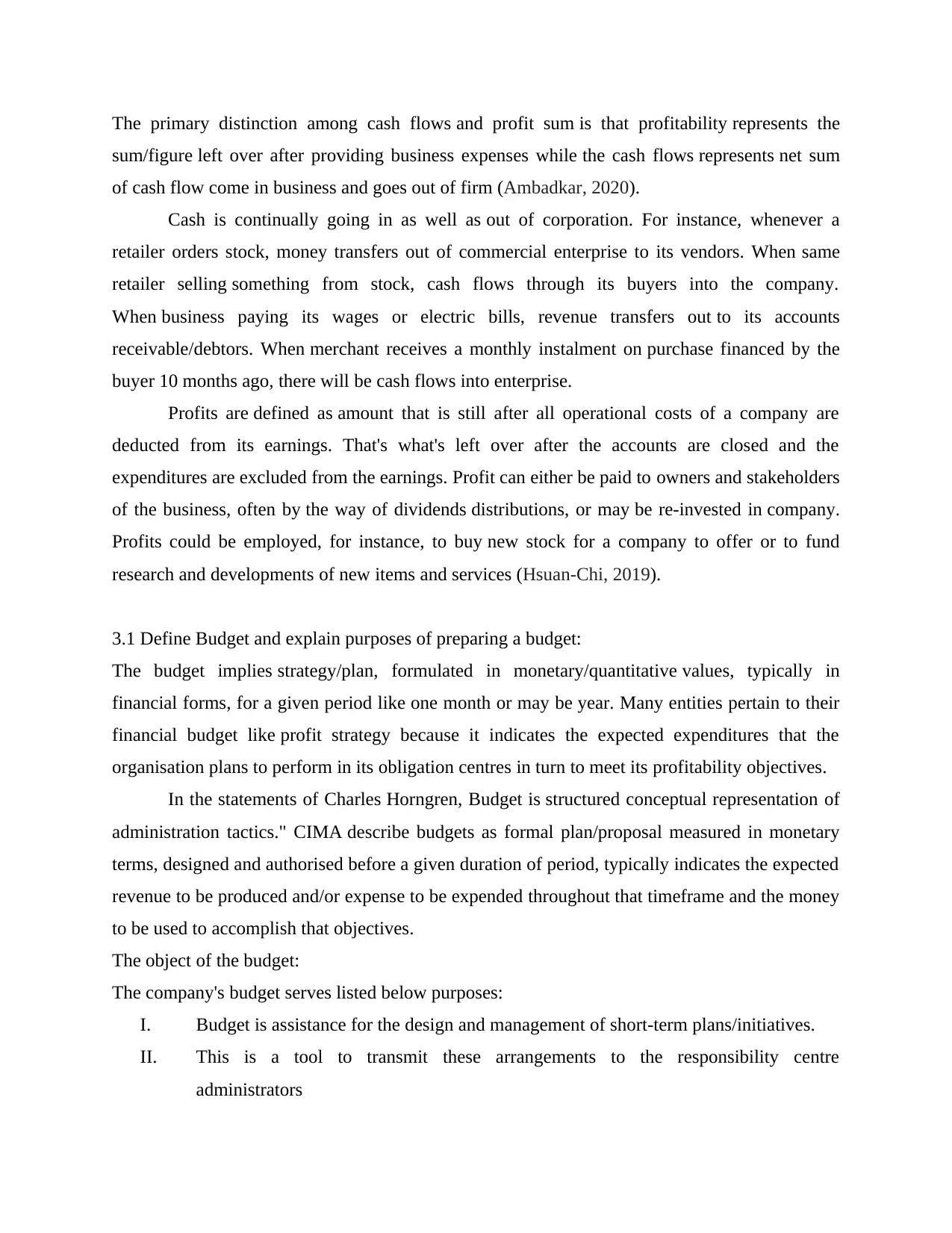
The primary distinction among cash flows and profit sum is that profitability represents the
sum/figure left over after providing business expenses while the cash flows represents net sum
of cash flow come in business and goes out of firm (Ambadkar, 2020).
Cash is continually going in as well as out of corporation. For instance, whenever a
retailer orders stock, money transfers out of commercial enterprise to its vendors. When same
retailer selling something from stock, cash flows through its buyers into the company.
When business paying its wages or electric bills, revenue transfers out to its accounts
receivable/debtors. When merchant receives a monthly instalment on purchase financed by the
buyer 10 months ago, there will be cash flows into enterprise.
Profits are defined as amount that is still after all operational costs of a company are
deducted from its earnings. That's what's left over after the accounts are closed and the
expenditures are excluded from the earnings. Profit can either be paid to owners and stakeholders
of the business, often by the way of dividends distributions, or may be re-invested in company.
Profits could be employed, for instance, to buy new stock for a company to offer or to fund
research and developments of new items and services (Hsuan-Chi, 2019).
3.1 Define Budget and explain purposes of preparing a budget:
The budget implies strategy/plan, formulated in monetary/quantitative values, typically in
financial forms, for a given period like one month or may be year. Many entities pertain to their
financial budget like profit strategy because it indicates the expected expenditures that the
organisation plans to perform in its obligation centres in turn to meet its profitability objectives.
In the statements of Charles Horngren, Budget is structured conceptual representation of
administration tactics." CIMA describe budgets as formal plan/proposal measured in monetary
terms, designed and authorised before a given duration of period, typically indicates the expected
revenue to be produced and/or expense to be expended throughout that timeframe and the money
to be used to accomplish that objectives.
The object of the budget:
The company's budget serves listed below purposes:
I. Budget is assistance for the design and management of short-term plans/initiatives.
II. This is a tool to transmit these arrangements to the responsibility centre
administrators
sum/figure left over after providing business expenses while the cash flows represents net sum
of cash flow come in business and goes out of firm (Ambadkar, 2020).
Cash is continually going in as well as out of corporation. For instance, whenever a
retailer orders stock, money transfers out of commercial enterprise to its vendors. When same
retailer selling something from stock, cash flows through its buyers into the company.
When business paying its wages or electric bills, revenue transfers out to its accounts
receivable/debtors. When merchant receives a monthly instalment on purchase financed by the
buyer 10 months ago, there will be cash flows into enterprise.
Profits are defined as amount that is still after all operational costs of a company are
deducted from its earnings. That's what's left over after the accounts are closed and the
expenditures are excluded from the earnings. Profit can either be paid to owners and stakeholders
of the business, often by the way of dividends distributions, or may be re-invested in company.
Profits could be employed, for instance, to buy new stock for a company to offer or to fund
research and developments of new items and services (Hsuan-Chi, 2019).
3.1 Define Budget and explain purposes of preparing a budget:
The budget implies strategy/plan, formulated in monetary/quantitative values, typically in
financial forms, for a given period like one month or may be year. Many entities pertain to their
financial budget like profit strategy because it indicates the expected expenditures that the
organisation plans to perform in its obligation centres in turn to meet its profitability objectives.
In the statements of Charles Horngren, Budget is structured conceptual representation of
administration tactics." CIMA describe budgets as formal plan/proposal measured in monetary
terms, designed and authorised before a given duration of period, typically indicates the expected
revenue to be produced and/or expense to be expended throughout that timeframe and the money
to be used to accomplish that objectives.
The object of the budget:
The company's budget serves listed below purposes:
I. Budget is assistance for the design and management of short-term plans/initiatives.
II. This is a tool to transmit these arrangements to the responsibility centre
administrators
Paraphrase This Document
Need a fresh take? Get an instant paraphrase of this document with our AI Paraphraser
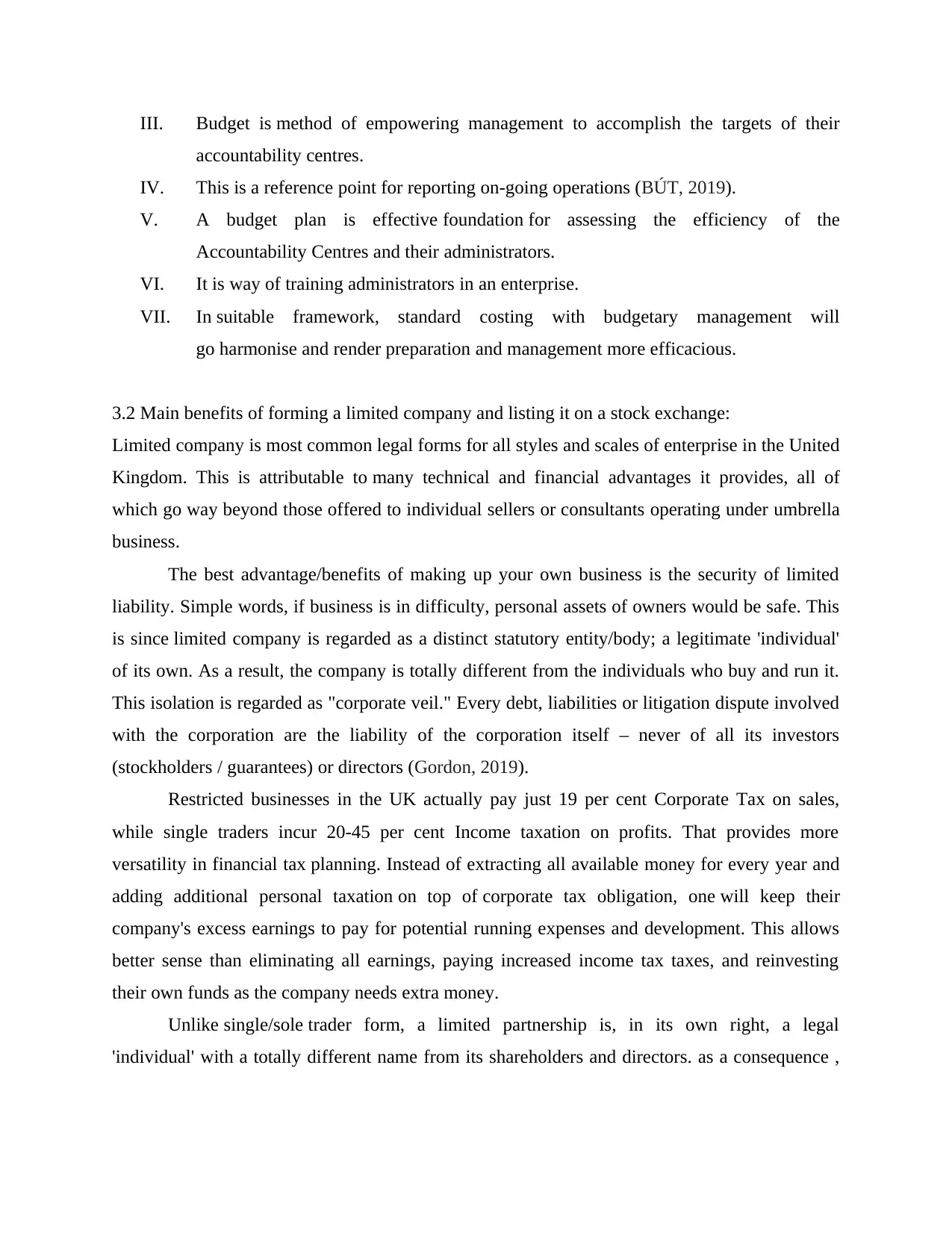
III. Budget is method of empowering management to accomplish the targets of their
accountability centres.
IV. This is a reference point for reporting on-going operations (BÚT, 2019).
V. A budget plan is effective foundation for assessing the efficiency of the
Accountability Centres and their administrators.
VI. It is way of training administrators in an enterprise.
VII. In suitable framework, standard costing with budgetary management will
go harmonise and render preparation and management more efficacious.
3.2 Main benefits of forming a limited company and listing it on a stock exchange:
Limited company is most common legal forms for all styles and scales of enterprise in the United
Kingdom. This is attributable to many technical and financial advantages it provides, all of
which go way beyond those offered to individual sellers or consultants operating under umbrella
business.
The best advantage/benefits of making up your own business is the security of limited
liability. Simple words, if business is in difficulty, personal assets of owners would be safe. This
is since limited company is regarded as a distinct statutory entity/body; a legitimate 'individual'
of its own. As a result, the company is totally different from the individuals who buy and run it.
This isolation is regarded as "corporate veil." Every debt, liabilities or litigation dispute involved
with the corporation are the liability of the corporation itself – never of all its investors
(stockholders / guarantees) or directors (Gordon, 2019).
Restricted businesses in the UK actually pay just 19 per cent Corporate Tax on sales,
while single traders incur 20-45 per cent Income taxation on profits. That provides more
versatility in financial tax planning. Instead of extracting all available money for every year and
adding additional personal taxation on top of corporate tax obligation, one will keep their
company's excess earnings to pay for potential running expenses and development. This allows
better sense than eliminating all earnings, paying increased income tax taxes, and reinvesting
their own funds as the company needs extra money.
Unlike single/sole trader form, a limited partnership is, in its own right, a legal
'individual' with a totally different name from its shareholders and directors. as a consequence ,
accountability centres.
IV. This is a reference point for reporting on-going operations (BÚT, 2019).
V. A budget plan is effective foundation for assessing the efficiency of the
Accountability Centres and their administrators.
VI. It is way of training administrators in an enterprise.
VII. In suitable framework, standard costing with budgetary management will
go harmonise and render preparation and management more efficacious.
3.2 Main benefits of forming a limited company and listing it on a stock exchange:
Limited company is most common legal forms for all styles and scales of enterprise in the United
Kingdom. This is attributable to many technical and financial advantages it provides, all of
which go way beyond those offered to individual sellers or consultants operating under umbrella
business.
The best advantage/benefits of making up your own business is the security of limited
liability. Simple words, if business is in difficulty, personal assets of owners would be safe. This
is since limited company is regarded as a distinct statutory entity/body; a legitimate 'individual'
of its own. As a result, the company is totally different from the individuals who buy and run it.
This isolation is regarded as "corporate veil." Every debt, liabilities or litigation dispute involved
with the corporation are the liability of the corporation itself – never of all its investors
(stockholders / guarantees) or directors (Gordon, 2019).
Restricted businesses in the UK actually pay just 19 per cent Corporate Tax on sales,
while single traders incur 20-45 per cent Income taxation on profits. That provides more
versatility in financial tax planning. Instead of extracting all available money for every year and
adding additional personal taxation on top of corporate tax obligation, one will keep their
company's excess earnings to pay for potential running expenses and development. This allows
better sense than eliminating all earnings, paying increased income tax taxes, and reinvesting
their own funds as the company needs extra money.
Unlike single/sole trader form, a limited partnership is, in its own right, a legal
'individual' with a totally different name from its shareholders and directors. as a consequence ,
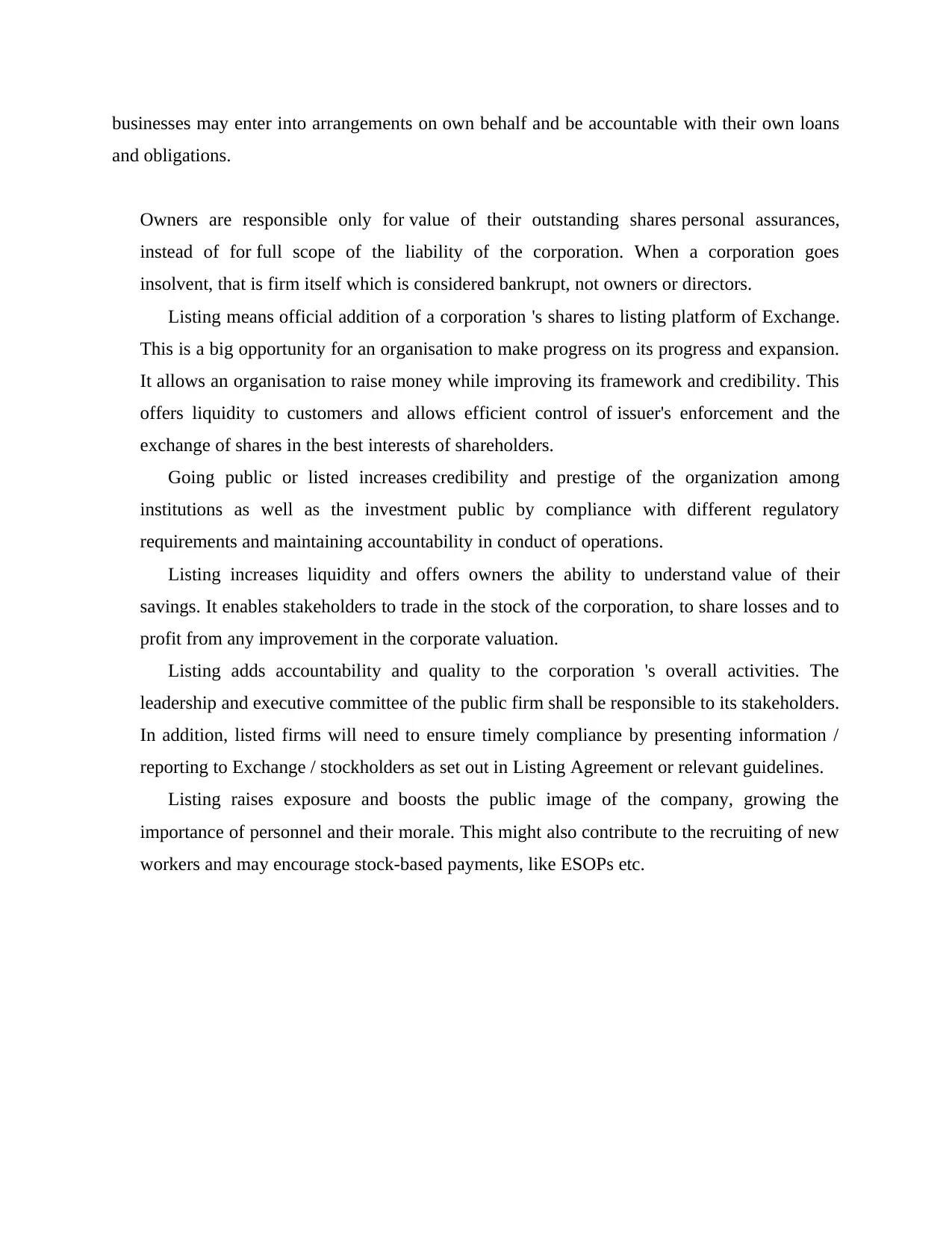
businesses may enter into arrangements on own behalf and be accountable with their own loans
and obligations.
Owners are responsible only for value of their outstanding shares personal assurances,
instead of for full scope of the liability of the corporation. When a corporation goes
insolvent, that is firm itself which is considered bankrupt, not owners or directors.
Listing means official addition of a corporation 's shares to listing platform of Exchange.
This is a big opportunity for an organisation to make progress on its progress and expansion.
It allows an organisation to raise money while improving its framework and credibility. This
offers liquidity to customers and allows efficient control of issuer's enforcement and the
exchange of shares in the best interests of shareholders.
Going public or listed increases credibility and prestige of the organization among
institutions as well as the investment public by compliance with different regulatory
requirements and maintaining accountability in conduct of operations.
Listing increases liquidity and offers owners the ability to understand value of their
savings. It enables stakeholders to trade in the stock of the corporation, to share losses and to
profit from any improvement in the corporate valuation.
Listing adds accountability and quality to the corporation 's overall activities. The
leadership and executive committee of the public firm shall be responsible to its stakeholders.
In addition, listed firms will need to ensure timely compliance by presenting information /
reporting to Exchange / stockholders as set out in Listing Agreement or relevant guidelines.
Listing raises exposure and boosts the public image of the company, growing the
importance of personnel and their morale. This might also contribute to the recruiting of new
workers and may encourage stock-based payments, like ESOPs etc.
and obligations.
Owners are responsible only for value of their outstanding shares personal assurances,
instead of for full scope of the liability of the corporation. When a corporation goes
insolvent, that is firm itself which is considered bankrupt, not owners or directors.
Listing means official addition of a corporation 's shares to listing platform of Exchange.
This is a big opportunity for an organisation to make progress on its progress and expansion.
It allows an organisation to raise money while improving its framework and credibility. This
offers liquidity to customers and allows efficient control of issuer's enforcement and the
exchange of shares in the best interests of shareholders.
Going public or listed increases credibility and prestige of the organization among
institutions as well as the investment public by compliance with different regulatory
requirements and maintaining accountability in conduct of operations.
Listing increases liquidity and offers owners the ability to understand value of their
savings. It enables stakeholders to trade in the stock of the corporation, to share losses and to
profit from any improvement in the corporate valuation.
Listing adds accountability and quality to the corporation 's overall activities. The
leadership and executive committee of the public firm shall be responsible to its stakeholders.
In addition, listed firms will need to ensure timely compliance by presenting information /
reporting to Exchange / stockholders as set out in Listing Agreement or relevant guidelines.
Listing raises exposure and boosts the public image of the company, growing the
importance of personnel and their morale. This might also contribute to the recruiting of new
workers and may encourage stock-based payments, like ESOPs etc.
⊘ This is a preview!⊘
Do you want full access?
Subscribe today to unlock all pages.

Trusted by 1+ million students worldwide
1 out of 14
Related Documents
Your All-in-One AI-Powered Toolkit for Academic Success.
+13062052269
info@desklib.com
Available 24*7 on WhatsApp / Email
![[object Object]](/_next/static/media/star-bottom.7253800d.svg)
Unlock your academic potential
Copyright © 2020–2025 A2Z Services. All Rights Reserved. Developed and managed by ZUCOL.





